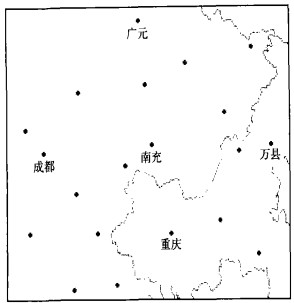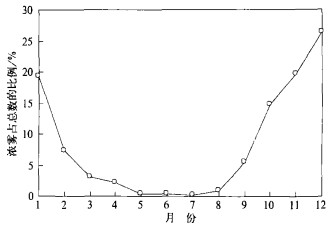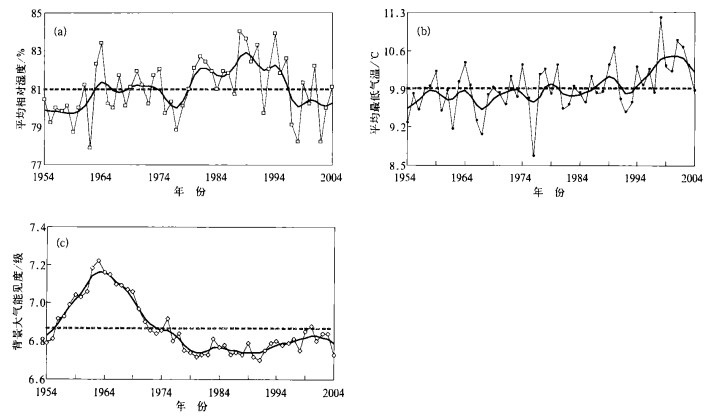四川盆地区域性浓雾序列及其年际和年代际变化
Regional Dense Fog Time Sequence with Its Annual and Decadal Variation in the Sichuan Basin
-
摘要: 利用四川盆地20个国家级基本气象站1954-2005年的大雾和能见度等资料, 探讨了区域性浓雾的认定标准, 建立起该地区较完整的区域性浓雾日数序列, 分析了其年际、年代际变化及可能原因.结果表明:①盆地内区域性浓雾主要发生在秋冬季 (9月至次年2月), 占总数的92.8%, 这也就决定了浓雾日数序列是一个跨年度统计的序列; ②1954-1976年盆地内浓雾处于偏少的负位相, 尤以20世纪60年代为最少, 相反, 20世纪80-90年代浓雾频次高、强度大, 处于多雾的正位相, 但是近些年有明显的减弱; ③在浓雾的年际和年代际变化中, 大气中凝结核的数量 (背景大气浑浊度) 起着主导作用, 同时, 干湿状况是决定浓雾年代际变化另一主要原因, 局地气候变暖对浓雾的影响具有不确定性; ④90年代以后盆地内浓雾的减弱是3个因子共同作用的结果.Abstract: According to the definition in the Surface Meteorological Observation Manual, dense fog is a kind of disastrous weather phenomenon that the visibility is less than 500 meters caused by abundant tiny water drops floating in the low atmosphere layer. Since the 1980s, the traffic has increased sharply with the developing of the national economy, and the damage caused by dense fog becomes more and more severe in China. As a result, much attention has been paid to studies on dense fog.Based on the available observation data set from 20 meteorology stations located in the Sichuan Basin where dense fog occurs frequently during 1954-2005, the time series of regional dense fog has been constructed under the criterion, during the same observation day there are 5 or more stations where dense fog emerge together, in the Sichuan Basin. Furthermore, the annual and decadal variation of this time series and possible change mechanism are discussed.Results show that most regional dense fogs occur mainly during autumn and winter (September to next February), and account for 92.8% of the annual amount. In summer, dense fog events are not prone to happening, only accout for 1.4%. So it means that the time sequence of dense fog in the Sichuan Basin spans two years, from July to June of next year. Taking the 51 years as a whole, regional dense fog has an increasing tendency with 2.96 days per decade in the Sichuan Basin. During 1954-1976, regional dense fog events are less than the average of 51 years, keeping a negative phase and 18.2 days per year, especially the 1960s is the least ten years, only 15 days per year. On the contrary, dense fogs are frequent and severe through 1980s and 1990s, keeping a positive phase. In recent years, dense fogs in the Sichuan Basin are decreasing, but the number is still more than that in the 1960s. There are significant negative correlation coefficients, not only at inter-decadal scales but also inter-annual scales, between dense fogs and visibilities of background atmosphere with no fog weather in autumn and winter. It explains that in the past 51 years the number of condensation nucleus is the decisive factor on the tendency of dense fogs in the Sichuan Basin. At the same time, the relative humidity of atmosphere is another main factor for dense fog change at inter-decadal scales despite the limit influence weaker at inter-annual scales, and the local temperature warming tendency doesn't exert obvious influence on dense fogs. In recent years, the change of condensation nucleus, relative humidity and temperature lead to the decline of regional dense fogs in the Sichuan Basin.
-
表 1 1954—2005年四川盆地单站或多站同时出现浓雾的年平均日数

表 2 四川盆地1954—2004年度区域性浓雾日数

表 3 四川盆地区域性浓雾日数与各因子的相关系数

-
[1] 黄荣辉, 张庆云, 阮水根, 等.我国气象灾害的预测预瞀与科学防灾减灾对策.北京:气象出版社, 2005:3-19 [2] 丁国安, 纪湘明, 房秀梅, 等.庐山云雾水化学组成的某些特征.气象学报, 1991, 49 (2):190-197. http://www.cnki.com.cn/Article/CJFDTOTAL-QXXB199102006.htm [3] 孙奕敏.灾害性浓雾.北京:气象出版社.1994:1-148. [4] 鲍宝堂, 束家鑫, 朱炳权.上海城市雾理化特性的研究.南京气象学院学报.1995, 18(1):114-118. http://www.cnki.com.cn/Article/CJFDTOTAL-NJQX501.016.htm [5] 李子华, 黄建平, 周毓荃, 等.1996年南京连续5天浓雾的物理结构特征.气象学报, 57(5):622-631. http://www.cnki.com.cn/Article/CJFDTOTAL-QXXB199905011.htm [6] 李子华.中国近40年来雾的研究.气象学报, 2001, 59(5):616-624. http://www.cnki.com.cn/Article/CJFDTOTAL-QXXB200105011.htm [7] 张利民, 石春娥, 杨军, 等.雾的数值模拟.北京:气象出版社, 2002:1-138. [8] 张光智, 卞林根, 王继志, 等.北京及周边地区雾形成的边界层特征.中国科学 (D辑), 2005, 35(A01):78-83. http://www.cnki.com.cn/Article/CJFDTOTAL-JDXK2005S1007.htm [9] 刘小宁, 张洪政, 李庆样, 等.我国大雾的气候特征及变化初步解释.应用气象学报, 2005, 16(2):220-230. http://qikan.camscma.cn/jams/ch/reader/view_abstract.aspx?file_no=20050227&flag=1 [10] 李子华, 仲良喜, 俞香仁.西南地区和长江下游雾的时空分布和物理结构.地理学报.1992, 47(3):242-251. http://www.cnki.com.cn/Article/CJFDTOTAL-DLXB199203004.htm [11] 李子华, 彭中贵.重庆市冬季雾的物理化学特征.气象学报, 1994, 52(4):477-483. http://www.cnki.com.cn/Article/CJFDTOTAL-QXXB404.010.htm [12] 柳泽文孝, 贾疏源, 赤田尚史, 等.成都市2002年1月2日至4日浓雾天气雾的化学组成.四川坏境, 2004, 23(1):6264. http://www.cnki.com.cn/Article/CJFDTOTAL-SCHJ200401020.htm [13] 中国气象局.地面气象观测规范.北京:气象出版社, 2003:21-27. [14] 葛良玉, 江燕如, 梁汉明, 等.1996年岁末沪宁线持续五天大雾的原因探讨.气象科学, 1998, 18(2):181-188. http://www.cnki.com.cn/Article/CJFDTOTAL-QXKX199802011.htm [15] 何立富, 李峰, 李泽椿.华北平原一次持续性大雾过程的动力和热力特征.应用气象学报, 2006, 17(2):160-168. http://qikan.camscma.cn/jams/ch/reader/view_abstract.aspx?file_no=20060228&flag=1 [16] 魏凤英.现代气候统计诊断预测技术.北京:气象出版社, 1999:15-61. [17] 中国气象局.气象辐射观测方法.北京:气象出版社, 1996:24-25. [18] 江玉华, 王强, 李子华, 等.重庆城区浓雾的基本特征.气象科技, 2004, 32(6):450-455. http://www.cnki.com.cn/Article/CJFDTOTAL-QXKJ200406013.htm -


 设为首页
设为首页 加入收藏
加入收藏



 下载:
下载:



